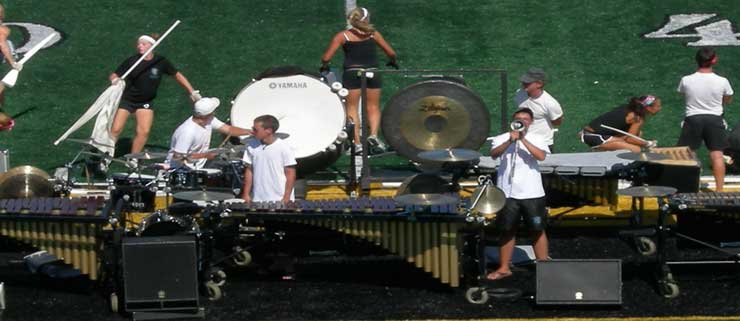 The modes of the melodic minor scale are usually paid less attention, from teachers and players alike, than the modes of the major scale, though their role and application in popular and art music is just as important. With four dominant modes (2, 4, 5, 7), a major mode (3), a minor mode (1) and a half-diminished mode (6), the melodic minor scale provides a vast palette of tonal colors that can be used to spice up any improvised solo, composition or arrangement. It is important to note that for jazz and popular music, only the ascending form of the melodic minor scale is used, and this article follows that convention.
The modes of the melodic minor scale are usually paid less attention, from teachers and players alike, than the modes of the major scale, though their role and application in popular and art music is just as important. With four dominant modes (2, 4, 5, 7), a major mode (3), a minor mode (1) and a half-diminished mode (6), the melodic minor scale provides a vast palette of tonal colors that can be used to spice up any improvised solo, composition or arrangement. It is important to note that for jazz and popular music, only the ascending form of the melodic minor scale is used, and this article follows that convention.
The following article provides an intervalic and chordal break-down of each mode of the melodic minor scale, and provides an explanation of how to apply each mode to a performance situation. For a similar break-down of the major scale modes please visit this article.
Legend
W = Whole-Step
H = Half-Step
R = Root of the Mode
Interval Structure = The make-up of each mode from the key of C, with each interval, either Whole-Step or Half-Step, listed beside the notes in the mode.
Chord Structure = The mode as it is found when stacked in thirds, providing a seven-note chord. The chord symbol next to each chord structure is the chord in its most detail, including all appropriate upper extensions.
Since there are no names for each mode of the melodic minor scale that are commonly agreed upon, such as the Greek names used for the major scale modes, this article will label each mode by the order in which it appears in the scale, Mode 1, Mode 2 etc. The names found next to each mode come from books written by Ron Miller and Gary Keller, who are two music educators that are trying to bring these melodic minor mode names into the common vernacular of jazz educators and musicians.
Mode 1 - Melodic Minor Scale (Ionian b3 or Dorian Nat 7)
The first mode of the Melodic Minor scale is very similar to the major scale, though it contains one crucial adjustment, the flatted third. When stacked in thirds the melodic minor scale forms a minor/major 7th chord, which is commonly used as the tonic minor chord in a iim7b5-V7alt-imMaj7 progression. Jazz musicians will often use this scale to improvise over a mMaj7 chord, as in the previous progression, while Bebop musicians such as Charlie Parker and Dizzy Gillespie also used this scale to improvise over the iim7 chord in a iim7-V7-Imaj7 chord progression.
Interval Structure
C D Eb F G A B C - W H W W W W H
Chord Structure - CmMaj7 (9, 11, 13)
C Eb G B D F A - R b3 5 7 9 11 13
Mode 2 - Phrygian Nat 6 or Dorian b2
The second mode of the melodic minor scale is closely related to the Dorian mode from the major scale, though it has a b9 (b2) interval instead. When stacked in thirds, this mode builds a 7susb9 or m7b9 chord. Because this scale can be used to improvise or compose a melody over both major and minor based chords, it is a very versatile mode that is often heard in modern jazz and modal jazz. The b9 (b2) interval provides a level of tension that is not found in the Dorian mode, and can be thought of as the "characteristic" note of this particular mode, similar to how the b9 is treated in the Phrygian mode of the major scale.
Interval Structure
D Eb F G A B C D - H W W W W H W
Chord Structure - Cm7 (b9), C7sus (b9, #9, 13)
D F A C Eb G B - R b3 5 b7 b9 11 13
Mode 3 - Lydian #5
The third mode of the melodic minor scale is closely related to the Lydian mode, though it contains a raised fifth interval, with all other notes being the same. When stacked in thirds, this mode forms a maj7 (#11,#5) which can be used as the Imaj7 chord in a iim7-V7-Imaj7 chord progression. In this instance the raised fifth provides an added level of tension that prevents the progression from sounding fully resolved. This can be an effective improvising or comping tool when playing over a Imaj7 chord that is not the tonic chord of the song, as it will help to give this new key its own character and distinguish it from the tonic Imaj7 chord.
Interval Structure
Eb F G A B C D Eb - W W W W H W H
Chord Structure - Cmaj7 (#11, #5, 13)
Eb G B D F A C - R 3 #5 7 9 #11 13
Mode 4 - Lydian Dominant Scale (Lydian b7 or Mixolydian #4)
The fourth mode of the melodic minor scale closely resembles the Mixolydian mode, though it contains a raised 11th (4th) that differentiates it from the related major mode. When stacked in thirds, the fourth mode of the melodic minor scale spells a 7(#11) chord that can be used in a number of different tonal situations. Players such as Emily Remler believe that this chord, 7 (#11), should only be used over a 7th chord that does not resolve down a fifth to a I chord of any type.
For example, in the opening bars of Ladybird, Remler would use it over the Bb7 chord in bar four,      Cmaj7/Cmaj7/Fm7/Bb7 (#11)/Cmaj7, since it resolves up a tone to the tonic Cmaj7 chord, and not down a fifth to Ebmaj7. Other players, such as Jake Langley and Pat Martino, commonly use this mode over any dominant 7th chord, especially in the context of a iim7-V7 (#11)-Imaj7 progression. For a great example of this chord being used in a compositional context refer to Sonny Rollins' composition Blue Seven which makes use of this mode for a majority of the chords and melody during the song.
Interval Structure
F G A B C D Eb F - W W W H W H W
Chord Structure - C7 (9, #11, 13)
F A C Eb G B D - R 3 5 b7 9 #11 13







 Scroll down to view the comparison chart of over a dozen different portable digital audio recorders.
Scroll down to view the comparison chart of over a dozen different portable digital audio recorders.